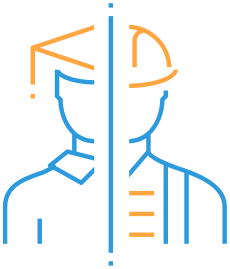Digital transformation looks to harness the possibilities and opportunities of new...

A Common Data Environment (CDE) is a central repository where construction project information is housed. It is the single source of information for the project. It is used to collect, manage, collaborate, and share project information with the project team..
A CDE is updated throughout the project lifecycle. It can hold information relating to all aspects of the project, including documents, contracts, reports, bids, and model information. A CDE enhances collaboration and increases security and the auditability of data. It also streamlines systems and processes used within and between the company and their supply chain.
Construction brings together a wide range of people from different disciplines, and a CDE brings together information from all who work as part of this wider project team.
Using a single source of information encourages and ensures collaboration between project members. This guarantees best practice, reduced errors, and avoids duplication. A CDE allows information to be stored in a secure environment. It provides a clear and secure audit trail of all changes and amendments.
Source: NBS Common Data Environments
Common Data Environment and BIM Compliance
A CDE follows the recommendations as defined in the PAS 1192 and BS 1192 documentation. These outline what AEC organizations need to do to reach a BIM Level 2 compliance on their projects.
PAS 1192 is part of the PAS (publicly available specification) series of documents and guidance. It outlines the specification for information management for the capital/delivery phase of construction projects using BIM. It is a supporting document achieving BIM Level 2 in the AEC industry.
The series of PAS documents seek to establish a framework for collaborative working and information requirements. The PAS guidelines are consistently developing, with document reviews occurring every two years.
BS 1192 outlines the method for the development, organization, and management of information. It should be implemented as standard practice as it outlines the best practice approach to collaborative working across the AEC sector. It describes a stringent process for collaboration and a specified naming policy.
As outlined, BIM Level 2 compliance requires projects to work collaboratively. It also requires project members to develop a process through which they can manage the information specific to their project. This collaboration also needs to be coordinated between various systems and project participants. Therefore, in order to work within a BIM environment a CDE should be a main priority for the project team.

Benefits of a Common Data Environment
A Common Data Environment is a single source of truth for a project. Some of the main advantages of implementing a CDE include:
-
Project team members have access to the latest, most up-to-date information within a shared area
-
Information is readily available to all project members at any time or location, including document and data information. For example, in a global project, team members can participate from anywhere in the world
-
Shared information is coordinated, reducing the time and effort required to check, version and reissue information
-
Project information is continually updated. All updates and changes logged in a secure audit trail maintaining a single source of information
-
Projects are created in a BIM environment and are aided in becoming BIM Level 2 compliant
-
Any number of documents can be generated from different combinations of model files
-
Project team members work collaboratively, and best practices are encouraged and ensured
-
Information can be reused to support construction planning, estimating, cost planning, facilities management, and many other downstream activities
-
Following the completion of the project asset information is readily available to handover

How to implement a Common Data Environment
The aim of introducing a CDE is to improve the creation, sharing, and issuing of information within a project. It ultimately ensures the delivery of a project.
When implementing a CDE there are a number of areas which need to be considered:
Project requirements
When implementing a CDE it is important to know what system is best suited to your needs. You need need to ensure all project teams have the information and platforms they require.
Appoint an information manager
The information manager is responsible for keeping the information generated and shared on the CDE clear and comprehendible.
Establish conventions as early as possible
File naming conventions, for example, should be adopted early on to ensure all project members are using a standard protocol.
Implement a workflow / sign-off process
It provides a clear understanding of what stage the information is at. Showing what work is currently in progress, what has been shared, and what has been published.
Separate project spaces
It may be necessary to divide the CDE to create separate environments on the central platform. This will help to meet the needs of different teams involved in the project.
Continuous reviews
Workspaces will need to be regularly reviewed to ensure all project members are fulfilling their obligations. This is also necessary to implement improvements if they are required.

The Asite Common Data Environment (CDE) sits within the Project Portfolio Management suite of solutions and provides organizations and their extended supply chain with shared visibility of their projects. Working to meet Asite’s vision to connect people and help the world build better, the Asite CDE incorporates the principles of openness and interoperability to help achieve this. You can speak to a member of the team or Book a Demo to find out more.
3 minute read
Asite Insights in your inbox.
Sign up for product news and our latest insights published monthly. It's a newsletter so hot, even global warming can't keep up.


